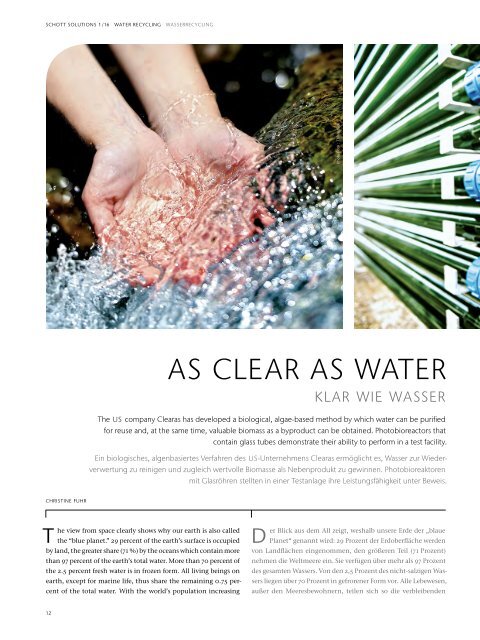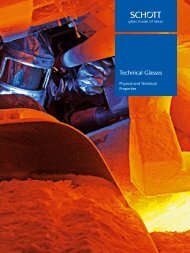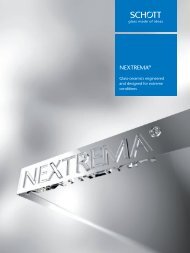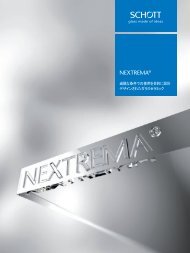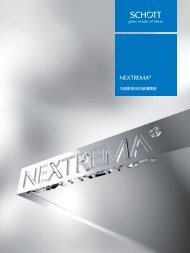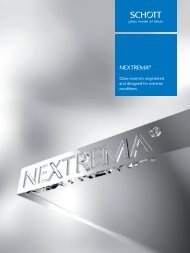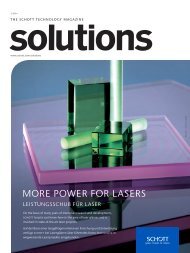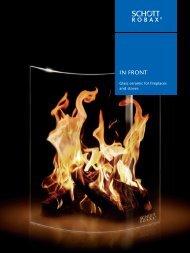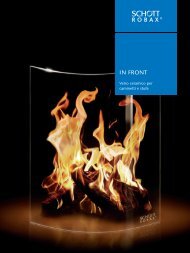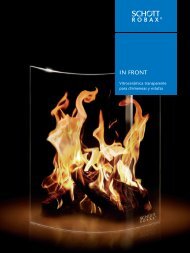Technology Magazine "SCHOTT solutions" Edition 1/2016
The SCHOTT solutions glass magazine features articles, reports and interviews on glass technological challenges from all over the world. The SCHOTT Technology Magazine. Beiträge, Reportagen und Interviews zu Lösungen von SCHOTT für technologische Herausforderungen weltweit.
The SCHOTT solutions glass magazine features articles, reports and interviews on glass technological challenges from all over the world.
The SCHOTT Technology Magazine. Beiträge, Reportagen und Interviews zu Lösungen von SCHOTT für technologische Herausforderungen weltweit.
You also want an ePaper? Increase the reach of your titles
YUMPU automatically turns print PDFs into web optimized ePapers that Google loves.
<strong>SCHOTT</strong> SOLUTIONS 1/16 WATER RECYCLING WASSERRECYCLING<br />
Photo Foto : Thinkstock<br />
AS CLEAR AS WATER<br />
KLAR WIE WASSER<br />
The US company Clearas has developed a biological, algae-based method by which water can be purifi ed<br />
for reuse and, at the same time, valuable biomass as a byproduct can be obtained. Photobioreactors that<br />
contain glass tubes demonstrate their ability to perform in a test facility.<br />
Ein biologisches, algenbasiertes Verfahren des US-Unternehmens Clearas ermöglicht es, Wasser zur Wiederverwertung<br />
zu reinigen und zugleich wertvolle Biomasse als Nebenprodukt zu gewinnen. Photobioreaktoren<br />
mit Glasröhren stellten in einer Testanlage ihre Leistungsfähigkeit unter Beweis.<br />
CHRISTINE FUHR<br />
T<br />
he view from space clearly shows why our earth is also called<br />
the “blue planet.” 29 percent of the earth’s surface is occupied<br />
by land, the greater share (71 %) by the oceans which contain more<br />
than 97 percent of the earth’s total water. More than 70 percent of<br />
the 2.5 percent fresh water is in frozen form. All living beings on<br />
earth, except for marine life, thus share the remaining 0.75 percent<br />
of the total water. With the world’s population increasing<br />
D<br />
er Blick aus dem All zeigt, weshalb unsere Erde der „blaue<br />
Planet“ genannt wird: 29 Prozent der Erdoberfläche werden<br />
von Landflächen eingenommen, den größeren Teil (71 Prozent)<br />
nehmen die Weltmeere ein. Sie verfügen über mehr als 97 Prozent<br />
des gesamten Wassers. Von den 2,5 Prozent des nicht-salzigen Wassers<br />
liegen über 70 Prozent in gefrorener Form vor. Alle Lebewesen,<br />
außer den Meeresbewohnern, teilen sich so die verbleibenden<br />
12


